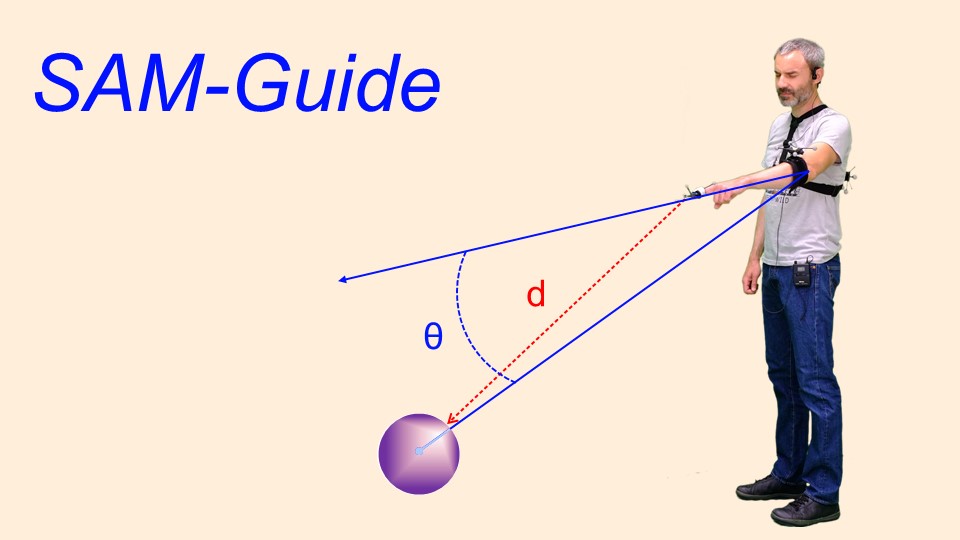- Share
- Share on Facebook
- Share on X
- Share on LinkedIn
Equipe Corps et Espace, Research

The Sam-Guide project is developing assistance systems for blind people, through sensory substitution: moving around, locating a target using sounds and vibrations. It unites the forces of researchers from five laboratories.
Univ. Grenoble-Alpes
Denis Pellerin, Traitement d'images
Univ. Normandie
Marc-Aurèle Rivière, Sciences cognitives
Elise Faugloire, Ergonomie
Ecole Polytechnique
Sylvain Ferrand, Sciences de l'ingénieur
In Grenoble, the LPNC (Body and Space team), in collaboration with the GIPSA-Lab (COPERNIC team), we are developing the AdVIS System, a virtual prototype allowing you to reach a target object without vision. The prototype is built on a choice of spatial metrics accessible from an artificial sensor, to be matched with a choice of percepts initiated by sound and tactile stimuli. The effectiveness and comfort of the human-machine interfacing resulting from these choices are tested on typical participants (blindfolded) mainly in a controlled environment, in the laboratory and virtually. In a hot-cold game, they seek to hit a 3-D virtual target in a motion-captured space. The deviations in angle and/or distance from this target are sent in real time according to the position of the index finger seeking to aim and then touch the target
At the University of Normandy, CERREV (Caen) in collaboration with LITIS (Rouen) are developing a tactile belt which indicates through vibrations on the skin around the user's waist their position in relation to beacons placed on their path .
In Palaiseau, the CMAP of the Polytechnique school is developing spatialized sound algorithms making it possible to place a "flying" sound source in front of the person's head as a virtual guide such as a "Tinkerbell" or "Navi" fairy. This fairy replaces a human assistant who normally runs in front of her in the corridor of an athletics stadium track. The culmination of this 24-month project is a festive disabled sports event modeled on the “Laser Run”, which is two combined modern pentathlon events. The person (blind, or deprived of vision) who runs on a circuit, approaches a shooting station with a table on which he must find and take in hand a laser gun, to shoot three times at a target before resume, possibly in relay, the rest of his race on the circuit. Performance requires coordination of the systems developed in the three sites. The main issue is not a hypothetical immediate improvement in the living conditions of these people, but a leisure activity; in fact, competitive play is a situation which stimulates the development of devices, then adapted to everyday life.
At NU, we guide a person along markers using a tactile belt At UGA, we guide by sound towards a 3D virtual target In Saclay, we guide a person on a racing circuit using spatial sound Bottom: Coordination will allow in Laser Run (modern pentathlon), without eyes, to run on a circuit, find the weapon, aim at the target...
Voir les publications dans le portail HAL ANR
Coordinateur & Partenaire
Coordinateur : Christian Graff (LABORATOIRE DE PSYCHOLOGIE ET NEUROCOGNITION)
Partenaires :
BORELLI Centre Borelli
LITIS LABORATOIRE D'INFORMATIQUE, DE TRAITEMENT DE L'INFORMATION ET DES SYSTÈMES - EA 4108
CesamS CENTRE D'ETUDE SPORT ET ACTIONS MOTRICES
LPNC LABORATOIRE DE PSYCHOLOGIE ET NEUROCOGNITION
GIPSA-lab Grenoble Images Parole Signal Automatique
CMAP Centre de mathématiques appliquées
à partir d'Octobre 2021 - 48 mois
- Share
- Share on Facebook
- Share on X
- Share on LinkedIn
